Geography
Soil – Problems of Indian Soil – Soil Erosion, Desertification
Soils of India
Table of Contents
Problems of Indian Soils
- Indian Soils faces various types of Problem namely –
-
-
-
- Soil Erosion – Water and Wind Erosion
- Desertification
- Waterlogging
- Salinity and Alkalinity
- Wasteland Formation
- Over exploitation of Soils etc.
-
-
- These problems mainly arises due to increased population and rise in living standards and due to urban encroachment of the agricultural fields.
A. Soil Erosion
- Removal of Soil by the forces of nature such as Wind and water, in such a manner that soil forming process can’t replace the soil is termed as Soil Erosion.
- In Simple terms, removal of topmost layer of the soil by the erosive agents such as Wind and Water is called as Soil Erosion.
- Top soil has most of the nutrients necessary for a plant’s growth. With depth, the fertility of the soil decreases. Erosion results in reduction of fertility of the soil by washing away the fertile top layer.
- Soil erosion usually happens at a much faster rate than soil formation, soil erosion leads to a gradual degradation of soil quality.
- Wind and water erosion are the two common types of soil erosion.
- Intensive agriculture, deforestation, roads, anthropogenic climate change and urban sprawl are amongst the most significant human activities in regard to their effect on stimulating erosion.
1. Wind Erosion
-
- Arid and semi-arid regions faces significant Wind erosion or Aeolian erosion.
- It occurs when winds blow over loose soil which is weakened by the absence of vegetative cover.
- Winds usually blow at high speeds in deserts due to absence of trees, removing the fertile, arable and loose soil leaving behind a depression devoid of top soil.

-
- Wind erosion increases manifold when the soil is dry, soils are subjected to overgrazing and devoid of vegetation cover.
- Desertification around desert regions is due to wind erosion.
- Very fine and medium sands are moved by wind in a succession of bounds and leaps, known as Saltation.
- Coarse sand is not usually airborne but rather is rolled along the soil surface and is called as Surface Creep.
- Very coarse sand and gravels are too large to be rolled by wind, so wind-eroded soils have surfaces covered with coarse fragments larger than 1.00 mm in diameter. This kind of arid soil surface is known as Desert Pavement.
2. Water Erosion
-
- Erosion by water is of multiple types – rainwater, seawater, and glacial.
- Rainwater erosion can be of the following types – rill, gully, sheet, and rain peeling erosion.
- Rainwater erosion takes place mainly in Hills and upper slopes of the Mountains.


-
- Rill Erosion – When the running water makes finger shaped grooves all over the area due to removal of soil with water.
- Gully Erosion – In this type of Erosion, the rills are enlarged and deepens, making land unsuitable for cultivation. Gullies formed over a large area gives rise to badland topography (Chambal Ravines).
- When a gully bed is eroded further, the bed gradually deepens and flattens out and a ravine is formed. The depth of a ravine may extend to 30 m or more.
- Further erosion of ravine beds gives rise to canyons. Canyons are few hundred meters deep and wide.
- Sheet erosion – When the entire top sheet of soil is washed away by water or by wind, leaving behind barren rock. Sheet erosion attacks a large area of top soil and renders the land almost unfit for cultivation.
- In the coastal areas, waves dash along the coast and cause heavy damage to soil. During the landfall of cyclones, storm surges destroy beaches and wash away the top layer. This is called sea erosion.
- In the higher reaches of the Himalayan region, soil erosion is caused by sowing moving glaciers. This is called glacial erosion.
Extent of Soil Erosion in India
-
- About 90 million hectares or about one-fourth of our total area is exposed to wind and water erosion.
- About one-eighth of Indian landmass is degraded due to severe erosion.
- The semi-arid to arid parts of Northwest India in Punjab, Haryana, Rajasthan, and Gujarat have witnessed the maximum soil degradation due to wind erosion.
- According to latest estimate about 8 million tonnes of soil has been removed from every square km area in desert during last 100 years.
- The loss due to water erosion is 53.34 million hectares annually.
- The states of Uttar Pradesh and Madhya Pradesh are severely affected by water erosion due to the formation of Gullies and ravines in Chambal and Kali river basins.
- The flood plains of Ganga and its tributaries in Uttar Pradesh and Bihar are carving out deep furrows and removing fertile top soil causing soil erosion.
- Coastal erosion around the coasts are caused by tidal waves and currents. Coast of Kerala, Tamil Nadu, Karnataka, Odisha, Maharashtra, Gujarat etc. are suffering with it.
Factors affecting Soil Erosion
-
- Intensity and duration of rainfall,
- Wind speed,
- Nature of soil and the physiography,
- Strong winds in dry areas,
- Human density,
- Deforestation,
- Overgrazing,
- Faulty methods of agriculture,
- Diversion of natural drainage courses,
- Wrong orientation of roads and railways, embankments and bridges.
Effects of Soil Erosion
-
- Fertile top soil is eroded leading to loss of fertility of soil.
- Flooding and leaching result in loss of mineral nutrients.
- Ground water level is lowered.
- There is decrease in soil moisture.
- Loss of natural vegetation.
- Frequency and intensity of floods and drought increases.
- Rivers, canals and tanks are silted and their water holding capacity decreases.
- The incidence and damaging power of landslides increases.
Human Factors of Soil Erosion
-
- Soil erosion is a combined result of numbers of Factors working together which includes natural as well as human activities.
- Various inappropriate activities which aggravated soil erosion includes –
-
- Deforestation
- Overgrazing by animals
- Faulty methods for Agriculture
-
- Besides these, diversion of Natural drainage, wrong orientation of roads and railways, embankments and bridges have added to the effect.
1. Deforestation
-
- Increasing pressures of human settlements over the forests have led to the diversion of forest lands for other purposes such as agriculture, habitations, timber extraction etc.
- Roots of trees and plants bind the soil particles and regulate the flow of water, thus saving soil from erosion. Deforestation make soil vulnerable to wind and water erosion.
- Forests also recycle nutrients by adding decomposed organic matter back to the soil. Deforestation affects the process of nutrient addition, rendering the soil short of adequate nutrients that can support healthy plant life.
- The large scale damage to soil in Shiwalik range, the Chos of Punjab, the ravines of Chambal valley are due to deforestation.

Major Causes of Deforestation
-
-
- Indiscriminate felling of trees as a result of agricultural operations, urbanization, industrialization, infrastructure development, mining operations, and use of wood for domestic and other purposes, have resulted in depletion of forests.
-
Shifting Cultivation
-
-
-
- In this practice a patch of land is cleared, vegetation is burned and the ash is mixed with the soil thus adding nutrients to the soil.
- This patch of land is used for raising crops for two to three years.
- Then this area is abandoned and is left to recover its fertility, and the same practice is repeated elsewhere on a fresh piece of land.
- This agricultural practice has become totally unsustainable due to rapid increase in population increasing pressure on the forested areas.
-
-
Development project and Mining
-
-
-
- Population pressure and development agenda have resulted in indiscriminate development of infrastructure, water reservoirs and dams, hydro power projects, roads and railways etc. This led to greater deforestation.
- Open cast mining has resulted in deforestation all over the world.
-
-
Plantation Boom
-
-
-
- Increase in demand for coffee, tea, sugar, rubber etc. have resulted in deforestation in the tropical rainforests.
-
-
Fuel Requirements
-
-
-
- The increasing demand for firewood with increasing population puts greater pressure on the forests, resulting in increased rate of deforestation.
-
-
Demand for Forest Resources
-
-
-
- Population pressure coupled with changes in standard of living have increased the demand for forest resources.
-
-
Raw Materials
-
-
-
- Wood is used as a raw material by various industries for making paper, plywood, furniture, match sticks, boxes, crates, packing cases, etc.
- Industries also obtain their raw materials from plants such as drugs, scents and perfumes, resin, gums, waxes, turpentine, latex and rubber, tannins, alkaloids, bees wax.
- This exerted tremendous pressure on forest ecosystem and their unrestricted exploitation for various other raw materials is the main cause of degradation of the forest ecosystem.
-
-
Other Causes
-
-
-
- Deforestation also results from overgrazing, agriculture, urbanization, flood, fire, pest, diseases, and defence and communication activities.
-
-
Effects of Deforestation
-
-
- Closed forests have being diminished due to deforestation leading to increase in degraded forests.
- Forests recycle moisture from soil into their immediate atmosphere by transpiration where it again precipitates as rain.
- Deforestation results in an immediate lowering of ground water level and in long-term reduction of precipitation.
- Much of the mining activity in India is being carried out in forest regions. The obvious result is deforestation and soil erosion.
- A large number of abandoned mines are lying in bad shape and are under extensive gully erosion leading to degradation of the habitat.
- Deforestation affects the biota and neighboring ecosystems, soil erosion, land degradation, alteration of ground water channels, pollution and scarce.
-
2. Overgrazing
-
- The movement of cattle over and over the pastures pulverizes the soil into finer particles due to the pressure applied by their hoofs resulting in erosion due to wind or heavy rainfall.
- During the dry season, when there is not enough fodder available near the fields, cattle are left to graze over the surrounding grasslands.
- This causes the grass to be torn out of the soil, along with the roots, which weakens the soil. The loose soil gets eroded easily when it rains.
- Soil degradation due to overgrazing is common in hilly regions.
3. Faulty Methods of Agriculture
-
- Much of the soil erosion in India is caused by faulty methods of agriculture.
- Wrong ploughing, lack of crop rotation and practice of shifting cultivation are the most adversely affecting methods of agriculture.
- Ploughing of land along the slopes makes it highly vulnerable to erosion by wind and water.
- In some parts of the country, the same crop is grown year after year which spoils the chemical balance of the soil. This soil is exhausted and is easily eroded by wind or water.
- Mono-cropping of cereals such as rice and wheat denudes the soil of essential nutrients.
- Shifting cultivation practiced in some areas in the north-eastern states. The removal of the forest cover leads to the exposure of the soil to rains and sun which results in loss of top soil.
- Faulty application of fertilizers such as excessive use of urea, in place of phosphate and potash, had led to a skewed ratio of soil nutrients, making the soil polluted and leading to loss of yields.
- Flood irrigation practiced in areas with canal irrigation, or in areas with plenty of groundwater is leading to water logging on the fields. On evaporation of water, the dissolved salt are left behind leading to soil salinization.
- Waterlogging and soil salinization is the important causes of soil degradation in Northwest India, particularly the states of Punjab, Haryana, and Rajasthan.
B. Desertification
- Desertification is the spread of Desert like conditions in arid or semi-arid areas due to human activities or climatic changes.
- In other words, it refers to the advancement of the desert into the adjacent regions, thereby affecting the fertility of nearby lands.
- It is estimated that the Thar Desert is advancing at an alarming rate of around 500 m every year. The desert which is surrounded by the Indus basin and the Aravalli’s is expanding on both the sides.
- Desert soils suffer maximum erosion by wind. The sand carried by wind is deposited on the adjoining fertile lands whose fertility dwindles and slowly the fertile land start merging with the advancing desert.
- Human activities like deforestation, overgrazing etc., aggravate the pace of desertification. Climate change has also contributed to desertification.

Ecological implications of desertification
-
- Drifting of sand and its accumulation on fertile agricultural land.
- Excessive soil erosion by wind and to some extent by water.
- Deposition of sand in rivers, lakes and other water bodies thereby decreasing their water containing capacity.
- Lowering of water table leading to acute water shortage.
- Increase in area under wastelands.
- Decrease in agricultural production.
- Increase in frequency and intensity of droughts.
Measures of Controlling Desertification
-
- Intensive tree plantation in the transition zones.
- Mulching shifting sand dunes in deserts with different plant species. Mulches serve as an effective physical barrier to the moving sand.
- Grazing should be controlled and new pastures should be developed.
- Indiscriminate felling of trees should be banned.
- Alternative sources of fuel can reduce the demand for fuelwood and reduce desertification.
- Sandy and wastelands should be put to proper use by judicious planning.
C. Waterlogging
- The flat surfaces and depressions make movement of Surface water sluggish results in waterlogging.
- Waterlogged soils are soaked with water accumulated during rainy season or due to leakage from various water sources.
- Extent of waterlogged soils is about 12 million hectares in India – half of which lies along the coast and the other half in the inland area.

- Waterlogging is believed to be one of the chief causes of salinity.
- Proper layout of drainage schemes is the only way to overcome the menace of waterlogging.
- The basic methods of removing excess water from waterlogged soils are –
-
-
- Surface drainage – Surface drainage involves the disposal of excess water over ground surface through an open drainage system with an adequate outlet. It is helpful where –
-
-
-
- Soils are deep with low infiltration
- Intensity of rainfall is high
- Water table is high
-
-
-
- Vertical drainage – Any bore or well from which the underlying water is extracted is defined as vertical drainage. It works well in Indo-Gangetic plain where the pumped water is used for irrigating the neighbouring regions.
- Surface drainage – Surface drainage involves the disposal of excess water over ground surface through an open drainage system with an adequate outlet. It is helpful where –
-
D. Soil Salinity and Soil Alkalinity
- Result of over irrigation in canal irrigated areas.
- The top soil of Saline and Alkaline Soils is saturated with saline and alkaline efflorescence i.e. covered with salt particles.
- In places where the drainage system is poor, the water with high salt concentration becomes stagnant and deposits all the salts in the top soil once the water evaporates.
- Regions with high sub-soil water table, injurious salts are transferred from below by the capillary action as a result of evaporation in dry season.
- Canal irrigated areas plenty of the water is available and the farmers indulge in over irrigation of their fields.
- Under such conditions, the ground water level rises and saline and alkaline efflorescence consisting of salts of sodium, calcium and magnesium appear on the surface as a layer of white salt through capillary action.
- Salinity means the dominance of Chloride and sulphates of Sodium, Calcium and Magnesium in the soil in such quantity so that it effects the soil fertility.
- Alkalinity implies the dominance of sodium salts, especially sodium carbonate.
- Although salts of alkali are somewhat different in their chemical properties from the salts of saline soils both soils occur in the same areas.
- Sandy soils are more prone to alkalinity and the loamy soils to salinity-alkalinity.
- It is estimated that about 80 lakh hectares of land (2.43% of the country’s total area) is affected by the problem of salinity and alkalinity.
- Vast tracts of canal irrigated areas in Uttar Pradesh. Punjab and Haryana; arid regions of Rajasthan, semi-arid areas of Maharashtra, Gujarat, Andhra Pradesh, Telangana and Karnataka etc. are facing this problem.
- Although Indira Gandhi canal in Rajasthan has turned the sandy desert into a granary, it has given birth to serious problems of salinity and alkalinity.

Effects of salinity and alkalinity
-
- Salinity and alkalinity have adverse effect on soil and reduce soil fertility.
- Cultivation is not possible on saline soils unless they are flushed out with large quantities of irrigation water to leach out the salts.
- Choice of crops is limited to salinity tolerant crops like cotton, barley etc.
- Quality of fodder becomes poor.
- Salinity and alkalinity create difficulties in building and road construction.
- These cause floods due to reduced infiltration of water which sometimes leads to damage to crops.
Steps to treat salinity and alkalinity
-
- Providing outlets for lands to drain out excess water and lower water table.
- Sealing leakages from canals, tanks and other water bodies by lining them.
- Making judicious use of irrigation facilities.
- Improve vegetal cover to avoid further degradation
- Planting salt tolerant vegetation and crops such as Barley, cotton, palm, linseed etc.
- Crop rotation with Dhaincha (green fodder) with other crops.
- Liberal application of gypsum to convert the alkalies into soluble compounds.
- Organic residues such as rice husks and rice straw can be added to promote formation of mild acid as a result of their decomposition.
- Flushing the salt by flooding the fields with excess water. However, this practice can lead to accumulation of saline water in the downstream area.
So, this was all about the Problems of Indian Soil namely Soil erosion, Desertification and Salinity and Alkalinity.
In the next post (Click Here), we will learn about the various practices to conserve the Indian Soils.

